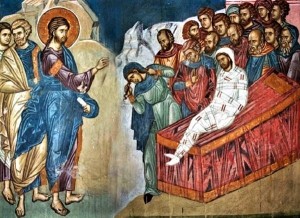The salvific weep of the soul
“Now it happened, that Jesus went into a city called Nain; and many of His disciples and a large crowd went with Him. And when He came near the city gate, behold, a dead man was being carried out, the only son of his mother, and she was a widow; and a large crowd of the city was with her. ”
And, what if a large crowd accompanied her? Even if the whole world was with her, no man or angel could bring a dead person back to life, i.e. to resurrect a man from the dead. But still there is One who can resurrect the dead and even deliver them out of Hades.
First, a note:
Sometimes it is good to use the Alexandrian allegorical school in combination with the Macedonian ascetic-hesychastic school of thought in the interpretation of the Gospel.
Thus, in this Gospel reading (Luke 7: 11–16), the dead person represents the mind of the man – held captive and dead by the passions, and his mother is the soul of a man; the stretcher on which the dead body is laid are the sins, while the gilders (pallbearers) are the demons. The people, i.e. the angels are sympathizing.
In wanting to derive spiritual benefit from this Gospel parable, without pretence I will state the only possible interpretation, namely: the dead man is carried on a stretcher by the pallbearers out of the city, i.e. the mind is dead, dead by its passions, lies in sin, and the demons carry it in the direction they want – outside the safety of the Kingdom of Heaven.
The mother weeps, i.e. the soul still cries and mourns over the death of the mind, which has no control over the passions and demons. An interesting condition that I would compare to the state of the mind of a person who finds themself in a very difficult addiction. It is good to ponder and discuss this spiritual condition: the mind is powerless to pull us out of the spiritual “blind alley” we are in, but our soul cries before God because of it. It seems that even then we have hope.
“When the Lord saw her, He had compassion on her, and said to her, ‘Do not weep!’ Then He came and touched the stretcher; and those who carried him stood still. ”
When the Lord saw her, He took pity on her, approached her (again and again: He first loved us, and not that we first loved Him), and touched the stretcher, i.e. He granted to the mind forgiveness of the sins as a cure of the addiction. At that moment the pallbearers stood still, i.e. demons can no longer act freely – when they are not intertwined to the passions.
The God-Man Christ said to the dead man, “Young man, I say to you, arise!”
The mind receives the first grace of the purification of its energy, and the first enlightenment happens to the mind, and with this the mind gains power over sin – the young man stood up and sat on the stretcher.
The resurrection of the dead man is the image of the first enlightenment of the mind.
And he began to speak, and that marks the beginning of the prayer. The mere existence of the prayer in a man is an indication that his mind is alive.
Jesus presented alive to the mother her only son, i.e. the soul regains one of the three forces, the rational force (the most important one). If the mind, as a rational force, is alive then it will easily stir the other two non-rational forces of the soul into action- the will, and the desire towards good.
“Then fear came upon all, and they glorified God, saying, ‘A great prophet has risen up among us’; and ‘God has visited His people'” – which is a normal thing.
Lord Jesus Christ, turn thy countenance towards me, as to the one without personal struggle (asceticism) and dead by the passions, and only because of the sorrow of my soul after You, resurrect me, so that I may be alive for my Heavenly Father, and dead for sin, in the Church of the Holy Spirit. Amen!
Most-Holy Theotokos, save us!
Metropolitan of Strumica Naum
(06.11.2021 16:55)

